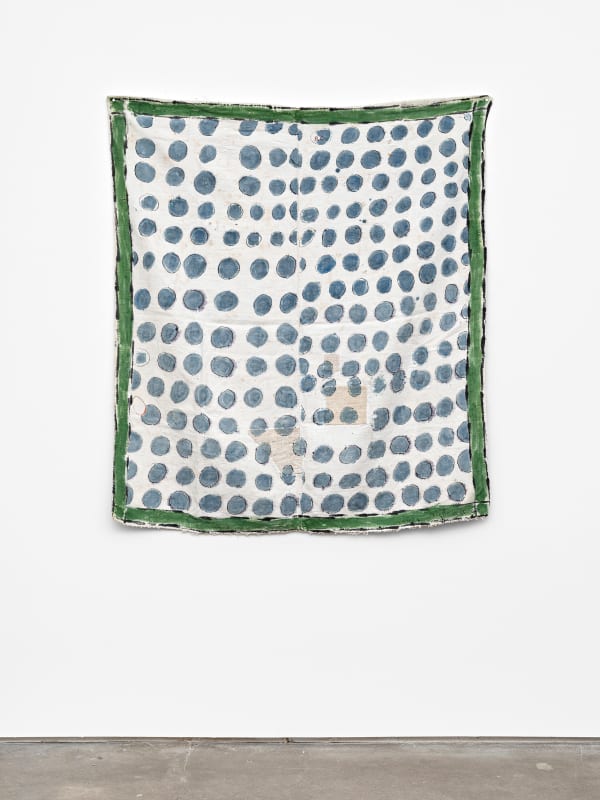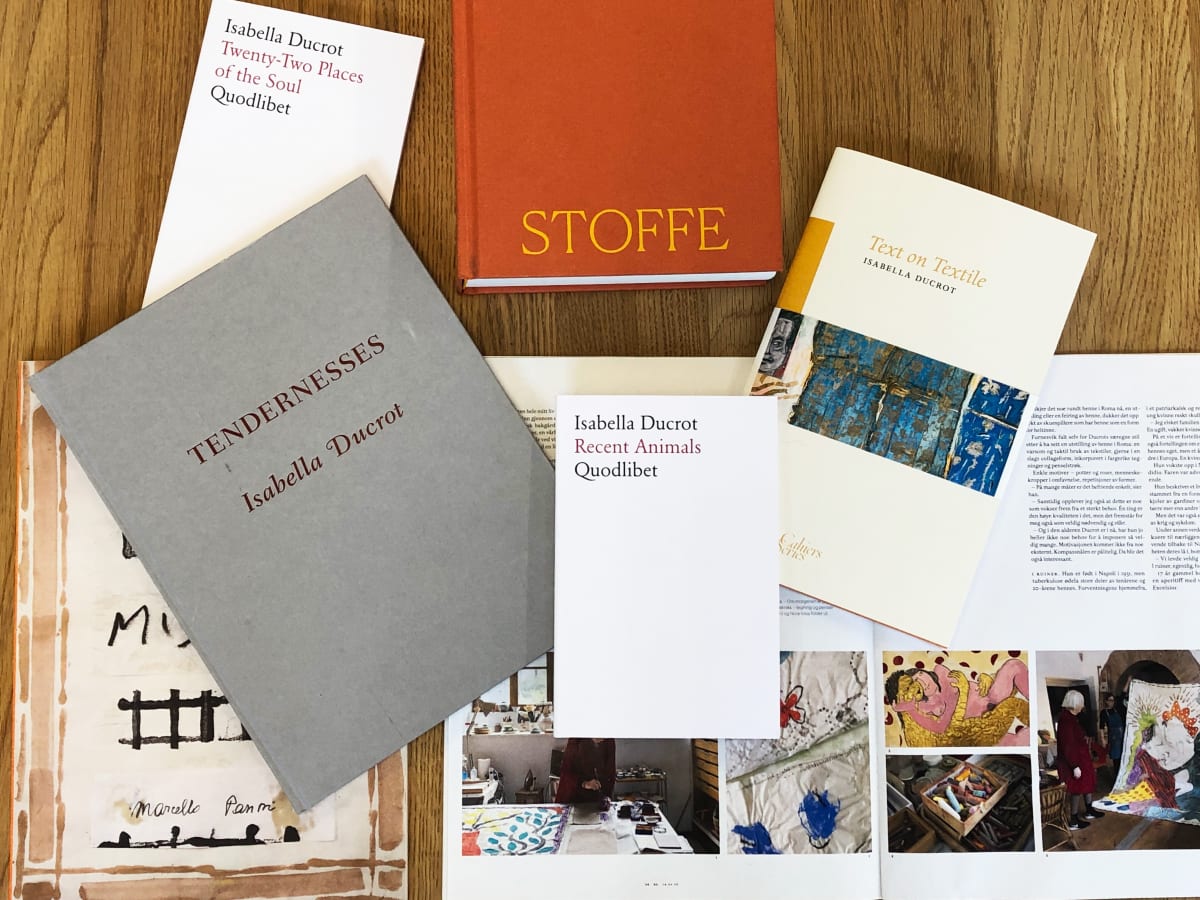ISABELLA DUCROT: “PAROLE E TESSUTI”
ISABELLA DUCROT
"PAROLE E TESSUTI"
14.03.-12.04.2025 / PREVIEW: FRIDAY 14.03.2024 / 19.00-21.00
-----
"Oh! Oh! Oh! Oh! Oh!" ... scribbled in ink, the same word is repeated across the coarse cotton fabric. Each repetition of the word is ever so slightly varied, ever so slightly unlevelled, and ever so slightly pinched together. Only by squeezing the letters together can you stack so many of them: they multiply, frantically fll up the surface, and unavoidably confront you with that "Oh!" comes with a sense of urgency. It is such a simple building block of language, yet still a word that starts sentences that are so vastly diferent in terms of emotions: "Oh, no!", Oh, yeah ...!","Oh, really?", "Oh, how wonderful!", or "Oh, shut up!" But "Oh! Oh! Oh! Oh! Oh!" are also the words that human beings would reach for when shutting up becomes unbearable. Human beings want to be heard, even when being told to shut up or when language fails them.
"Oh!", as an interjection does not hold any specifc meaning, other than being a signifer, and sometimes an amplifer, of surprise or emotions. In the works of Isabella Ducrot, however, it never introduces any sentences. Rather, Ducrot isolates the word and locates it at the periphery of our language, where words so easily transform into mere sounds. Here, "Oh! Oh! Oh! Oh! Oh!", fades in and out of meaning; it is a droning sound, it is a pulsating rhythm, it is the babbling of a baby, it is the wailing cry of an animal, or the prayer of a human being when words are turning into tears. It is the moment of being overwhelmed and feeling sure that the advice of Ludwig Wittgenstein - that of "Whereof one cannot speak, thereof one must be silent" - is not an adequate response to certain events in this world. For Ducrot, being born in 1931 and being someone who lived through World War II, there is an overwhelming sense of inadequacy in one's own power or the power that language holds when once again seeing the atrocities of war unfolding in Europe. "Oh!", becomes a manner to respond, recognising that you have no authority while still recognising that you have a responsibility: I am here as a witness!
The "Oh!" is thus marking a presence and a sense of compassion: I am here and I see you! Possibly, it is the very simplicity of "Oh!"that provides the reason for its common application; that it is one of those words that seem to belong to what Noam Chomsky labelled "universal grammar". Chomsky stated that regardless of what native language we are given the task to learn as children, we are already equipped with an understanding of the basic structures of any human language. "Oh!", is universally understood! Or even more so - as suggested by the title of Isabella Ducrot's most recent book (which will be published at the time of the exhibition), "Recent Animals"- it is a word or a sound that is commonly understood among all creatures. The insistent repetition of "Oh!", has it somewhat taking on the pace and pattern of the mantra, that it matches this method to steer one's sense and to seek a state of calm, concentration or, indeed, comfort. In doing so, the mantra would strive to focus on the self while at the same time striving to connect with what is beyond itself. Similarly Ducrot's works are marked by a deep sense of humanism while seemingly also being drawn towards a divine power. Like the "deus ex machine"of the Greek tragedies - that suddenly interrupts the play to resolve what had seemed to be an irresolvable plot situation - the "Oh!" is calling out for compassion and a sense of justice in the universe.
And it is done so in the most modest of manners: in handwritten ink on a worn and weathered piece of fabric. Most commonly, these are pieces of textiles that Ducrot gathered during decades of travels around Asia. A tea towel, a pillow case, a shirt - she would consider the sourcing of these textiles as creative of a gesture as any mark that would make herself. And rather than diferentiating between art and craft, Ducrot considers herself an equal that is working together with those that initially wove these fabrics, maintained them and mended them. The work is now made up a myriad of marks: her letters, her painted circles, her recognisable framing of the motif, which sits on top of the stitches, the patches, the stains, the structure of the weave, and the patina made up by years of use of these textiles. And the work now also allows for the story of how we care for these fabrics as well as how they care for us. How they wrap us. How they warm us. How they allow for intimacy and allow for us to express our individuality, our history, or our sense of belonging to a community.
"Cy Twombly told me: "Every human being wants to make their mark!", Isabella revealed in a recent studio visit. He had told her so at a moment in time when she was not too sure of herself as an artist. However, these words instilled a sense of self belief and provided her with a liberating credo - that she still to this day, at the age of 93, would remind herself of - allowing her to work freely and ofering an equally liberating lens through which to see the world and the works of others. In the end, the grand monuments and masterworks of art history and the thin, fne stitches that prolong the life of a seemingly worthless Japanese tea towel, are all human eforts to fll this world with beauty, meaning and marks that declare: I was here!
Isabella Ducrot (b. 1931, Naples, lives and works in Rome, Italy). Her recent solo exhibitions include Le Consortium, Dijon, France (2024); Sandra and Giancarlo Bonollo Foundation for contemporary art, Vicenza, Italy (2024); MAXXI Taormina, Italy (2023); Art Basel Unlimited, Basel, Switzerland (2022); San Giuseppe alle Scalze a Pontecorvo, Napoli, Italy (2021); Spazio Parlato, Palermo, Italy (2018); and Museo Archeologico Nazionale di Napoli, Napoli, Italy (2015). Ducrot was also subject to a large-scale solo presentation at the recent Frieze Masters, curated by Sheena Wagstaf and under the auspices of Galerie Gisela Capitain, Sadie Coles HQ and STANDARD (OSLO). Next year will also see a major retrospective of her works open at her hometown museum of Madre in Napoli, Italy, curated by Adam Weinberg.
STANDARD (OSLO) will also host a book launch for Isabella Ducrot's upcoming publication, "Recent Animals" (published by Quodlibet S.r.l., Macerata), on the 9th of April.
-----







































